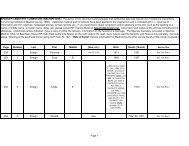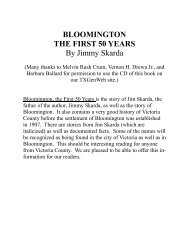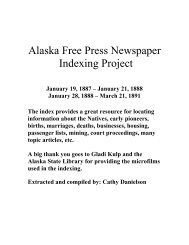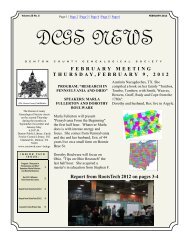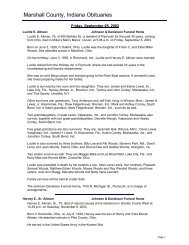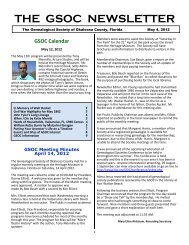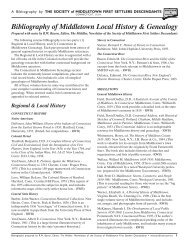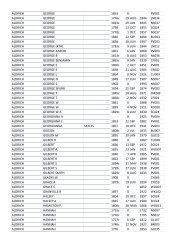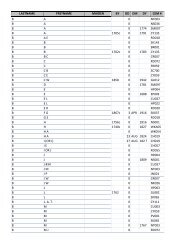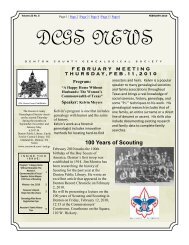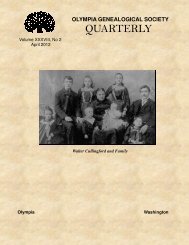Indian population in the United States and Alaska. 1910 - RootsWeb
Indian population in the United States and Alaska. 1910 - RootsWeb
Indian population in the United States and Alaska. 1910 - RootsWeb
You also want an ePaper? Increase the reach of your titles
YUMPU automatically turns print PDFs into web optimized ePapers that Google loves.
88 INDIANS IN THE UNITED STATES.<br />
MiwoTc.—The ma<strong>in</strong> <strong>and</strong> largest subdivision of this<br />
stock. They have no dist<strong>in</strong>ctive popular name, be<strong>in</strong>g<br />
usually known only by <strong>the</strong> mean<strong>in</strong>gless term of" Digger<br />
<strong>Indian</strong>s." Their habitat, s<strong>in</strong>ce known to Europeans<br />
<strong>in</strong> <strong>the</strong> eighteenth century, has been <strong>in</strong> central California,<br />
<strong>and</strong> may be roughly described as extend<strong>in</strong>g north<br />
<strong>and</strong> south from <strong>the</strong> Cosumnes River to Fresno Creek,<br />
<strong>and</strong> east <strong>and</strong> west from <strong>the</strong> crest of <strong>the</strong> Sierras to <strong>the</strong><br />
San Joaqu<strong>in</strong> River. The Miwok, as enumerated <strong>in</strong><br />
<strong>1910</strong>, numbered 670, of which" 669 were <strong>in</strong> CaUfornia<br />
<strong>and</strong> 1 <strong>in</strong> Nevada.<br />
MUSKHOGEAN STOCK.<br />
Stock as a whole.—One of <strong>the</strong> five largest stocks <strong>in</strong><br />
<strong>the</strong> <strong>United</strong> <strong>States</strong>. At <strong>the</strong> time first known to Euro-peans,<br />
<strong>in</strong> <strong>the</strong> sixteenth century, it occupied a compact<br />
s<strong>in</strong>gle area compris<strong>in</strong>g <strong>the</strong> largest part of Mississippi,<br />
Alabama, <strong>and</strong> western <strong>and</strong> sou<strong>the</strong>rn Georgia, toge<strong>the</strong>r<br />
with <strong>the</strong> nor<strong>the</strong>rn half of Florida.<br />
The <strong>Indian</strong>s of <strong>the</strong> Muskhogean stock, as enumerated<br />
<strong>in</strong> <strong>1910</strong>, numbered 29,191. To this figure should be<br />
added perhaps 1,500 for <strong>Indian</strong>s of this stock reported<br />
without dist<strong>in</strong>ction of tribe among <strong>the</strong> general <strong>population</strong><br />
<strong>in</strong> Alabama, Mississippi, Georgia, Florida, <strong>and</strong><br />
Oklahoma, mak<strong>in</strong>g a probable total of between 30,000<br />
<strong>and</strong> 31,000. The tribes of this stock, for which mem-<br />
bers were reported, are as follows:<br />
Alibamu. Choctaw. Koasati.<br />
CMckasaw. Creek. Sem<strong>in</strong>ole.<br />
AWbamu.—^A tribe closely related to <strong>the</strong> Koasati <strong>and</strong><br />
formerly belong<strong>in</strong>g to <strong>the</strong> Creek Confederacy. Their<br />
earliest known habitat was on <strong>the</strong> lower Alabama<br />
River <strong>in</strong> Alabama. At <strong>the</strong> end of <strong>the</strong> eighteenth century<br />
<strong>and</strong> <strong>in</strong> <strong>the</strong> early portion of <strong>the</strong> n<strong>in</strong>eteenth century<br />
part of <strong>the</strong> tribe removed to Louisiana, part to Polk<br />
County, Tex., <strong>and</strong> part followed <strong>the</strong> Creeks to <strong>Indian</strong><br />
Territory. The renmants are now found <strong>in</strong> all three<br />
of <strong>the</strong>se localities, only those <strong>in</strong> Oklahoma be<strong>in</strong>g located<br />
on any reservation. These latter were not enumerated<br />
as Alibamu by <strong>the</strong> census. The number reported <strong>in</strong><br />
<strong>1910</strong> was 298, of which 187 were <strong>in</strong> Texas <strong>and</strong> 111 <strong>in</strong><br />
Louisiana.<br />
CMckasaw.—One of <strong>the</strong> larger tribes of this stock<br />
whose early habitat was <strong>in</strong> nor<strong>the</strong>rn Mississippi. By<br />
<strong>the</strong> b^<strong>in</strong>n<strong>in</strong>g of <strong>the</strong> n<strong>in</strong>eteenth century <strong>the</strong>y began to<br />
move westward to what is now Oklahoma, <strong>and</strong> <strong>in</strong> 1855<br />
were given a separate reservation <strong>the</strong>re.<br />
The number enumerated <strong>in</strong> <strong>1910</strong> was 4,2p4, of which<br />
4,191 were <strong>in</strong> Oklahoma. Comparison with earher<br />
years is made difficult by <strong>the</strong> fact that' until 1898 <strong>the</strong><br />
Chickasaw were not returned <strong>in</strong> <strong>the</strong> reports of <strong>the</strong><br />
Commissioner of <strong>Indian</strong> Affairs separate from freedmen<br />
(Negroes) <strong>and</strong> <strong>in</strong>termarried whites.* S<strong>in</strong>ce 1898<br />
<strong>the</strong> figures for this tribe <strong>in</strong> Oklahoma are as follows<br />
TEAK.<br />
:



